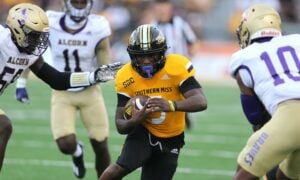Offensive Lines Don’t Matter, Volume Does
I don’t want to be wrong, so I listen to people who disagree. When I hear smart people suggesting that Rashaad Penny isn’t a top three pick – or even a top three running back – in this year’s rookie drafts, I need to answer some questions. I have him at 1.02/3. He’s currently pick six in consensus rookie rankings here at DLF.
One of the questions about him is that even though the Seahawks reached for him in the first round, their terrible offensive line isn’t good enough to support significant fantasy production.
It’s true; Seattle’s O-line is bad, and it looks like it could stay that way. They have perpetually refused to try and improve it through any reasonable means from drafting to trading.
[am4show have=’g1;’ guest_error=’sub_message’ user_error=’sub_message’ ]
But everything else about Penny seems to place him in the top few running backs in what is considered a heavy running back class. When I run him through my running back model, he comes in second place behind Saquon Barkley. Apparently, the Seahawks agreed.
So I set out to try and see how unlikely it is a running back can be a top 24 player with a bad O-line.
O-line Grades Vs Volume
The first thing I did is head over to FFstatistics.com, where you can download a complete RB database with stats and data going back to 2000 with the click of a button. It includes O-Line grades that are taken from fantasyoutsiders.com as well as all stats by year and positional rankings.
I organized the database by year and limited it to only running backs who had finished in the top 24 in PPR scoring since 2000. Because I need to “see” things to really understand them, I highlighted the draft round of a player when they had a bottom 12 o-line in yellow, and their team name in red when they had less than 30% share of rushing attempts.
The idea here is: What’s more likely, an RB in the top 24 with a poor o-line, or low volume? Here are the top 24 RBs in PPR in 2017:

I did this for every class going back to 2000, but I’ll post last five years to save you some time and still provide relevant player names for context:
2016

2015

2014

2013

Needless to say, it became clear very quickly that while RBs are often in the top 24 with a poorly graded O-line, they are rarely in the top 24 with a low volume.
I’m not suggesting that O-line doesn’t matter. I also think there could be ways to adjust this, for example using rushing grades instead of overall O-Line grades. But I think that outside of the extremes we would still see the same pattern. But for the majority of running backs, O-lines are not a deal breaker, or important – in any way really, for fantasy points – compared to volume.

There is a small trend, here, obviously. Again, O-lines do matter. But it’s awfully flat outside of the top and bottom five, and 1-3% of players with a bottom five O-line vs 3-4% with a top five isn’t a very strong case to fade one particular running back who scores well in everything else from draft capital to college market share.
The trend for volume with fantasy points, on the other hand, is rock solid.

“How about those exceptions though, huh?”
Good question imaginary, friend! If you were to look at those last five years of data again you might notice anyone with rush attempts in the top 24 also seems to have high target volume. Those with low rushing volume tend to have very high target volume.
Here is every RB with less than 30% rush attempts and below average target share since 2000.

I highlight the averaged rushing attempts and target share above the table in this picture (55% rush, 10% target>). Only nine out of 432 top 24 seasons had below average rushing attempts and coupled it with a below average target share. You don’t have to look at the list for very long before you find the answer. (Tevin Coleman is a dead giveaway for big play outlier seasons.)
Again, the O-line does matter, but volume just matters more.

Since the 2000 season, 83% of running backs who have finished in the top 24 had over a 50% or more share of their teams rushing attempts compared to only 58% with a top ten O-line.

To put it another way; nearly half of the top 24 running backs since 2000 have had a below average O-line, and an O-line ranked in the bottom seven is more likely to produce a top 24 running backs than a rushing share under 40%.
So, the question isn’t “is the Seahawks O-Line bad?” or “How bad is it?” or “do the Seahawks even have an O-Line anymore?” Instead, it’s “Will Rashaad Penny have more than 40% of the total rushing attempts for Seattle in 2018?”
To which the answer is, say it with me now…..you bet your bippy he will (probably).

The team has continued to try running the ball since Marshawn Lynch left the team but has struggled with injuries, and sub-replacement level talent. Even Christine Michael and Thomas Rawls were given close to 30% in partial seasons, and the less said about last year the better.
I’ve been thinking about this thread since I saw it yesterday, and didn’t want to jump the gun with a quick response. I have to agree with the notion that heavy usage is perhaps a better indicator of top RB finishers than good Oline play. /1
— Ryan C Finley (@RyanCFinley) May 7, 2018
But what about the analysis you have here that makes me worry is this: attempting to dictate usage. Maybe it would best be coupled with analysis around which rushing attacks most often give the lion’s share of the work to a single back. /2
— Ryan C Finley (@RyanCFinley) May 7, 2018
As DLF’s own Ryan Finley pointed out, I am projecting usage – which is a dangerous game. But I think the team’s intent to run is fairly clear and was made clearer by their decision to draft a running back in the first round.
Conclusion
Now, will Penny make it all 16 games? That’s a fair question – a much better question than “is his O-line bad?” for example, because that doesn’t matter. However, it’s also a fair question for any running back in the NFL. So it doesn’t seem to be a reason to value anyone over/under anyone else.
Now, if you want to tie poor O-line grades to injury potential, that’s an idea. But I haven’t seen anything that shows a correlation between the two. So you’ll have to break out some data and prove it. FFstatistics.com is there for you too, so have at it.
But outside of proving something else, I have to say that I don’t care what it “feels” like. Take those feelings to a yoga class, this is fantasy football for “gawd” sake. Here we care about winning.
Rashaad Penny is a top three running back in the 2018 draft class.
This article is based on a thread I posted that become popular recently. Check it out to see all the great responses and counter ideas along with them:
O-Lines Don't Matter, Volume Does – A Thread:
I don't want to be wrong, so I listen to people who disagree. Something that comes up in the Penny isn't a top-3 pick argument is SEA terrible Olinehttps://t.co/rmTgzsyF1z here we come pic.twitter.com/LJX8b3IWsk
— Peter Howard (@pahowdy) May 6, 2018
[/am4show]
- Peter Howard: Dynasty Fantasy Football Superflex Rankings Explained - March 6, 2024
- Dynasty Target and Regression Trends: Week 15 - December 23, 2023
- Dynasty Target and Regression Trends: Week 14 - December 16, 2023


































































